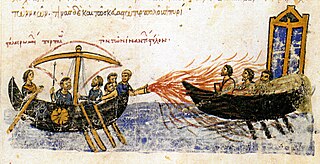 W
WA flamethrower is a ranged incendiary device designed to project a controllable jet of fire. First deployed by the Byzantine Empire in the 7th century AD, flamethrowers saw use in modern times during World War I, and more widely in World War II as a tactical siege weapon against fortifications.
 W
WThe Abwehrflammenwerfer 42 was a German static defensive flamethrower, flame fougasse or flame mine used during the Second World War. The design was copied from Russian FOG-1 mines that were encountered in 1941 during Operation Barbarossa. These were usually buried at intervals of 12 to 30 yards covering road blocks, landing beaches, harbour walls and other obstacles. They were normally mixed in with other mines or emplaced behind barbed wire and could be command detonated or triggered by tripwires or other devices.
 W
WThe DGFM flamethrower was a flamethrower of Argentine origin manufactured in the 1916s by Dirección General de Fabricaciones Militares.
 W
WThe Einstossflammenwerfer 46 was a hand held single shot flamethrower designed in Germany during the second half of World War II and introduced in 1944; it was engineered to be both cheap and easily mass-produced. The disposable weapon fired a half-second burst of flame of up to 27 metres (89 ft). It was issued to the Volkssturm or the Werwolf movement, but also used by the Fallschirmjäger . It was inspired by the Italian "Lanciafiamme Mod. 41 d'assalto"
 W
WThe Fierce-fire Oil Cabinet was a double-piston pump naphtha flamethrower first recorded to have been used in 919 AD in China, during the Five Dynasties and Ten Kingdoms period.
 W
W W
WA flame tank is a type of tank equipped with a flamethrower, most commonly used to supplement combined arms attacks against fortifications, confined spaces, or other obstacles. The type only reached significant use in the Second World War, during which the United States, Soviet Union, Germany, Italy, Japan and the United Kingdom all produced flamethrower-equipped tanks.
 W
WThe Flammenwerfer 35, or FmW 35 was a one-man German flamethrower used during World War II to clear out trenches and buildings. It could project fuel up to 25 metres from the user.
 W
WThe Flammenwerfer 41, or FmW 41 was the standard German flamethrower beginning in 1941 and an upgraded version of the earlier Flammenwerfer 35, whose main issue was its excessive weight of 36kg, with the Flammenwerfer 41 being only 18. It performed a similar role of other flamethrowers of the time, namely clearing enemy trenches and buildings in highly fortified areas. From 1942 to April 1945, 64,284 examples were produced. After 1945, flamethrowers gradually saw less usage, and the Bundeswehr does not use any.
 W
WThe Flammenwerfer M.16. was a German man-portable backpack flamethrower that was used in World War I in trench warfare. It was the first flamethrower to be used in combat ever, in 1915 at Verdun. It was also used in 1918 in the battle of Argonne Forest in France against Allied forces, as featured in the 2001 film The Lost Battalion, although an account in a 1917 issue of The Living Age suggests eye witness accounts of it being used at the Battle of the Somme in 1916.
 W
WGreek fire was an incendiary weapon used by the Byzantine Empire beginning c. 672. Used to set fire to enemy ships, it consisted of a combustible compound emitted by a flame-throwing weapon. Some historians believe it could be ignited on contact with water, and was probably based on naphtha and quicklime. The Byzantines typically used it in naval battles to great effect, as it could supposedly continue burning while floating on water. The technological advantage it provided was responsible for many key Byzantine military victories, most notably the salvation of Constantinople from the first and second Arab sieges, thus securing the Empire's survival.
 W
WThe K pattern flamethrower was a man-portable backpack flamethrower, produced in occupied Poland during World War II for the underground Home Army. These flamethrowers were used in the Warsaw Uprising in 1944.
 W
WThe first German man-portable flamethrower was called the Kleinflammenwerfer or "Kleif". Fuel was stored in a large vertical, cylindrical backpack container. High-pressure propellant was stored in another, smaller container attached to the fuel tank. A long hose connected the fuel tank to a lance tube with an igniting device at the nozzle. The propellant forced the fuel through the hose and out of the nozzle at high speed when a valve was opened. The igniting device at the nozzle set fire to the fuel as it sprayed out. The flamethrower was operated by two soldiers, one carrying the fuel and propellant tanks, another wielding the lance. Wex, a replacement for the Kleif, was introduced in 1917 after the third battle of Ypres.
 W
WThe Lanciafiamme Spalleggiato Modello 35, also known as Model 35, was a flamethrower issued to the Royal Italian Army in the Second Italo-Ethiopian War. In 1940 it was replaced by the Lanciafiamme Spalleggiato Modello 40, which uses a different ignition system.
 W
WMeng Huo You is the name given to petroleum in ancient China, which practiced the use of petroleum as an incendiary weapon in warfare.
 W
WThe "Ronson" flamethrower was developed for mechanized applications during World War II and used by the Canadian Army and the United States Marine Corps.
 W
WThe Wechselapparat ("Wex") was a World War I German flamethrower introduced in 1916 to replace the earlier Kleif. It had a doughnut-shaped backpack fuel container with a spherical propellant container in the middle. This design was updated before the Second World War to become flamethrower model 35. However, model 35 was considered too fragile so it was soon replaced by the model 41, a simpler construction with smaller, horizontal, cylindrical backpack containers.